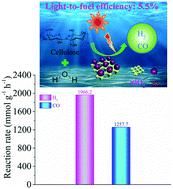当前位置:
X-MOL 学术
›
Energy Environ. Sci.
›
论文详情
Our official English website, www.x-mol.net, welcomes your feedback! (Note: you will need to create a separate account there.)
Highly efficient UV-visible-infrared light-driven photothermocatalytic steam biomass reforming to H2 on Ni nanoparticles loaded on mesoporous silica
Energy & Environmental Science ( IF 32.5 ) Pub Date : 2022-05-23 , DOI: 10.1039/d2ee00816e Chongyang Zhou 1 , Jichun Wu 1 , Yuanzhi Li 1 , Huamin Cao 1
Energy & Environmental Science ( IF 32.5 ) Pub Date : 2022-05-23 , DOI: 10.1039/d2ee00816e Chongyang Zhou 1 , Jichun Wu 1 , Yuanzhi Li 1 , Huamin Cao 1
Affiliation

|
Solar-driven photocatalytic H2 production from biomass using semiconductor photocatalysts provides a sustainable route for the generation of renewable fuel alternatives to fossil fuels. To date, this route is limited by its relatively low H2 production rate. Here, we report a route of photothermocatalytic steam cellulose reforming to generate H2 and CO on a catalyst of nickel nanoparticles loaded on mesoporous silica merely using focused illumination of the entire solar spectrum or visible-infrared light. Extremely high production rates of H2 and CO (1966.2 and 1257.7 mmol gcatalyst−1 h−1) together with a light-to-fuel efficiency of 5.5% are achieved. The route is also highly efficient for the steam reforming of a range of biomasses, such as agricultural and urban organic wastes. We reveal that the high catalytic efficiency is ascribed to the perfect integration of good thermocatalytic activity and intense absorption across the entire solar spectrum of loaded nickel nanoparticles, resulting in an efficient light-driven thermocatalytic process. The process is further significantly promoted by photoactivation in which carbon oxidation as the rate-determining step of steam cellulose reforming is substantially accelerated upon illumination. The substantially promoted carbon oxidation is related to chemisorbed oxygen on metallic Ni nanoparticles being activated upon illumination.
中文翻译:

高效紫外-可见-红外光驱动的光热催化蒸汽生物质在负载于介孔二氧化硅上的 Ni 纳米粒子上重整为 H2
使用半导体光催化剂从生物质中太阳能驱动的光催化 H 2生产为生成化石燃料的可再生燃料替代品提供了一条可持续的途径。迄今为止,这条路线受到其相对较低的 H 2产率的限制。在这里,我们报告了一种光热催化蒸汽纤维素重整路线,在负载在介孔二氧化硅上的镍纳米颗粒催化剂上仅使用整个太阳光谱或可见红外光的聚焦照明来产生 H 2和 CO。极高的 H 2和 CO 产率(1966.2 和 1257.7 mmol g催化剂-1 h -1) 以及 5.5% 的轻燃料效率。该路线对于一系列生物质的蒸汽重整也非常有效,例如农业和城市有机废物。我们揭示了高催化效率归因于负载的镍纳米粒子在整个太阳光谱中的良好热催化活性和强烈吸收的完美结合,从而产生了高效的光驱动热催化过程。该过程通过光活化进一步显着促进,其中作为蒸汽纤维素重整的速率决定步骤的碳氧化在光照时显着加速。显着促进的碳氧化与金属镍纳米颗粒上化学吸附的氧在光照时被激活有关。
更新日期:2022-05-23
中文翻译:

高效紫外-可见-红外光驱动的光热催化蒸汽生物质在负载于介孔二氧化硅上的 Ni 纳米粒子上重整为 H2
使用半导体光催化剂从生物质中太阳能驱动的光催化 H 2生产为生成化石燃料的可再生燃料替代品提供了一条可持续的途径。迄今为止,这条路线受到其相对较低的 H 2产率的限制。在这里,我们报告了一种光热催化蒸汽纤维素重整路线,在负载在介孔二氧化硅上的镍纳米颗粒催化剂上仅使用整个太阳光谱或可见红外光的聚焦照明来产生 H 2和 CO。极高的 H 2和 CO 产率(1966.2 和 1257.7 mmol g催化剂-1 h -1) 以及 5.5% 的轻燃料效率。该路线对于一系列生物质的蒸汽重整也非常有效,例如农业和城市有机废物。我们揭示了高催化效率归因于负载的镍纳米粒子在整个太阳光谱中的良好热催化活性和强烈吸收的完美结合,从而产生了高效的光驱动热催化过程。该过程通过光活化进一步显着促进,其中作为蒸汽纤维素重整的速率决定步骤的碳氧化在光照时显着加速。显着促进的碳氧化与金属镍纳米颗粒上化学吸附的氧在光照时被激活有关。


























 京公网安备 11010802027423号
京公网安备 11010802027423号